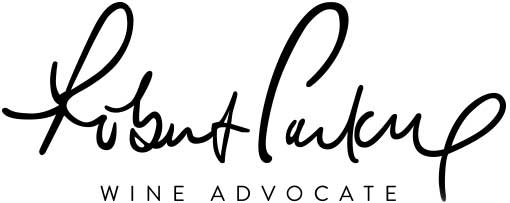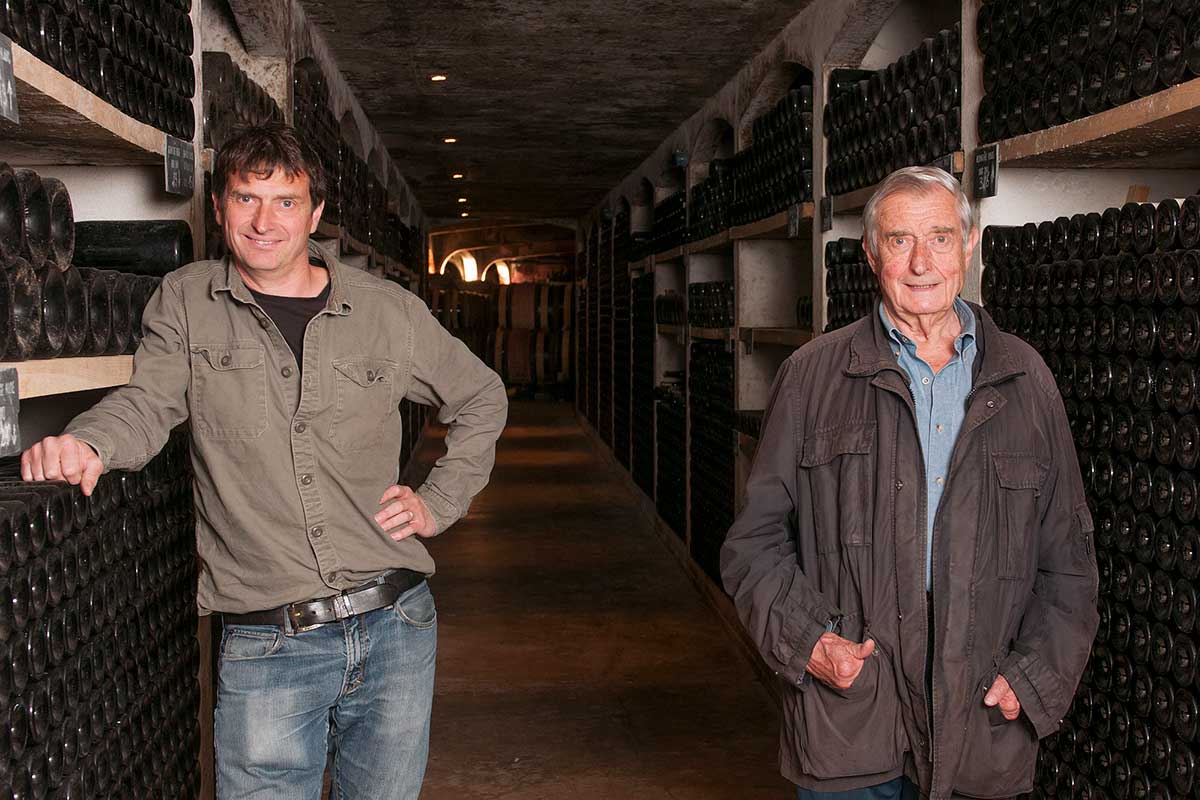
Jean Louis Chave: Saint Joseph 2018
- 2
- Syrah 100%
- 5
- rot, trocken
- 15,0% Vol.
- Trinkreife: 2026–2046
- Verpackt in: 12er
- 9
- saftig
- pikant & würzig
- strukturiert
- 3
- Lobenberg: 95–96/100
- Wine Spectator: 95/100
- Galloni: 94/100
- Parker: 93–95/100
- Jeb Dunnuck: 92–94,/100
- 6
- Frankreich, Rhone, Nordrhone
- 7
- Allergene: Sulfite,
Abfüllerinformation
Abfüller / Importeur: Jean Louis Chave, 37 Avenue Saint Joseph, 07300 Mauves, FRANKREICH

/100
Wine Spectator über: Saint Joseph
-- Wine Spectator: Very pure and refined, with flavors of plum, cassis and bitter cherry layered seamlessly, while a piercing sanguine note and flecks of savory, black tea and sweet bay peek in throughout. Fine-grained on the finish. Lovely. Best from 2023 through 2035. 95/100

/100
Galloni über: Saint Joseph
-- Galloni: Saturated violet color. Mineral-accented blackberry, cherry-cola and olive scents show fine delineation and an exotic spice nuance. Densely packed but lively as well, offering intense dark fruit preserve and olive flavors that are complemented by candied violet, espresso and cracked pepper notes. Shows excellent concentration as well as energy, closing with bright mineral cut, harmonious tannins and strong, floral-driven persistence. 94/100

/100
Parker über: Saint Joseph
-- Parker: Still in component parts, the 2018 Saint Joseph should be another winner. The least concentrated, yet still exceptional Chalaix (92 - 94) displayed enticing notes of violets, blueberries and licorice; the Dardouille (93 - 95) was lusher and suppler, loaded with black cherries; and the Bachasson (94 - 96) was the most complex, mixing herbs and licorice with plummy fruit. 92-95/100Jean-Louis Chave seems increasingly confident at the helm of this legendary domaine. We spent a bit of time discussing the 2018 vintage, which he rates highly. 'The wines are not really jammy. They're almost as ripe as 2003, but for some reason the grapes weren't raisiny,' he said. 'The vines never really stopped. In mid-August, we had 40 millimeters of rain—perfect timing. And at the end of August another little rain.' Hermitage shines this year. 'In Hermitage, you can push things to the limit and still be OK,' Chave said. 'Even when it's extreme, the grands terroirs are still the grands terroirs.' Looking at recent vintages, Chave summarized the similarities as follows: 2015 he compares to 1990; 2016 to 2010; 2017 to 2000. As for 2018, said Chave, 'It wouldn't be right to compare 2018 and 2003. The ripeness is extreme, but at the end, they're very different wines.' Hermitage aside, Chave has spent much of his time in recent years working on his vineyards in Saint Joseph. He said he thinks of Saint Joseph as a wine for bistros rather than haute cuisine, but Chave's Saint Joseph's have quickly progressed beyond that in terms of quality (and, unfortunately, price).

/100
Jeb Dunnuck über: Saint Joseph
-- Jeb Dunnuck: Looking at the 2018 from barrel, I was able to taste two barrel samples of the 2018 Saint Joseph. It’s largely in the same style as the 2017 and just textbook Saint Joseph with its darker, mineral-laced fruits and smoked meat and pepper aromas and flavors. It’s beautifully done, medium to full-bodied, and will drink nicely in its youth yet also age. 92-94/100This bastion of traditionally made wines lies in the tiny village of Mauves, just south of Hermitage, and few wine drinking experiences compare to an evening spent in Jean-Louis Chave’s cellar tasting through the different terroirs of Hermitage and Saint Joseph. It has unquestionably been one of the highlights of my year going on a decade now. Founded in 1481 and with over 500 years of winemaking history, Domaine Chave has seen an incredible succession of talented vignerons, with Gérard Chave, who was born in 1935, managing the estate brilliantly up through 1990. Gérard slowly began handing the reins of the estate over to his son, Jean-Louis (born in 1968), in the late 1980s and early 1990s. While Gérard is still involved, the weight of this historic estate falls firm on the shoulder of the more than capable Jean-Louis Chave today. While this family has always stayed firmly planted in tradition, they’re far from dogmatic, nor do they rest on their laurels or reputation. They’ve recently completed work on a new cellar (just across the street from their existing cellar and connected via a tunnel) in 2014, and have resurrected new vineyard sites in Saint Joseph. While the new cellar includes a state-of-the-art lab, Jean-Louis has always been quick to point out, “You don’t need a lab to make great wine.” Along with the help of Jean-Louis’ wife, Erin Cannon-Chave, they also continued to grow their négoçiant label, Chave Selection, which offers fabulous bang-for-the-buck and includes both Northern and Southern Rhônes. While this estate is rightly known for its Hermitage, Jean-Louis has invested the past ten years or more in resurrecting older vineyards in Saint Joseph, with some sites just now coming online. They currently release an Estate Saint Joseph, which comes from a mix of their estate terroirs, and a Saint Joseph Le Clos, which is a single vineyard located just south of Mauves. The Estate Saint Joseph is a classic example of the appellation and offers ample dark, blacker fruits, minerality, and peppery characteristics as well as a touch of austerity and building structure. The Saint Joseph Le Clos comes from a warmer, earlier terroir and is always more refined, elegant, and seamless, with redder fruits and a perfumed, spice-driven style. Both are brilliant, singular wines, and I’ve no doubt the best is still to come here. Looking at Chave’s Hermitage releases, all the grapes are destemmed (I believe some stems were included before the 1980s) and the individual terroirs are vinified separately. Starting in 1990 and 1991, the Chaves replaced their old concrete fermenters with stainless steel tanks. They continue today to use their three larger oak uprights for vinification as well, due to the ability to perform punch-downs. Aging occurs in small French oak barrels with the amount of new oak falling in the 20-30% range. The wines are then blended in tank and bottled without being filtered. If needed, the wines can see a light egg-white fining before bottling. In addition to the classic Hermitage, Chave can release a small production Cuvée Cathelin, which generally comes all from the Les Bessards lieu-dit and sees slightly more time in oak. Only made in the great vintages (1990, 1991, 1995, 1998, 2000, 2003, 2009, 2010, and 2015), it’s almost impossible to find bottles of this elixir, but it’s usually a more opulent, powerful wine compared to the classically styled Hermitage release. Regardless of the wine, the style here is beautifully transparent, and the wines always show the vintage characteristics clearly (which Jean-Louis likes to describe as either a “Granite” year or a “Sun” year). While the wines have the balance and purity to dish out plenty of pleasure in their youth, they age beautifully, with Jean-Louis recommending at least 15 years of cellaring for most vintages of his Hermitage. With more and more of Hermitage going to giant corporations these days, it’s inspiring to see this small, family-owned estate still sitting at the top of the hierarchy, both in Hermitage and the entire world of wine. Jean-Louis is still young (and has a young son who takes after him, and a daredevil daughter who takes after Erin), so the future is very bright at this estate!
Jean Louis Chave
Die Familie Chave erzeugt bereits seit sechshundert Jahren Hermitage und zählt zweifelsohne zu den besten Weinproduzenten der Welt. Die Weine der jetzigen Generation, Vater Gerard und Sohn Jean Louis, sind Kultweine erster Güte, ungemein rar und schwer zu finden.


